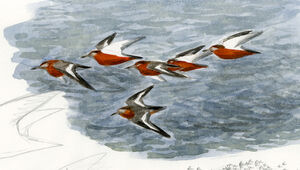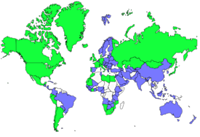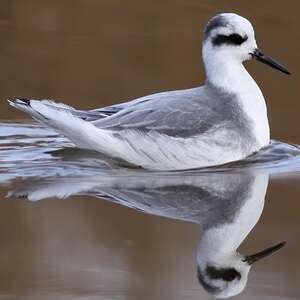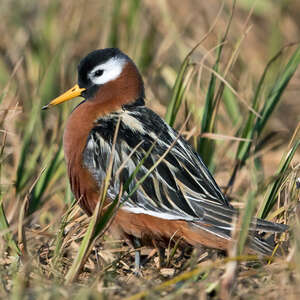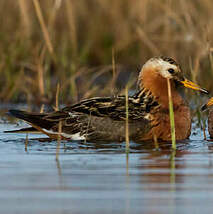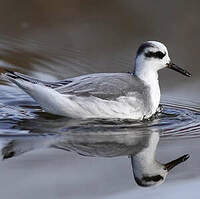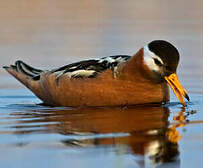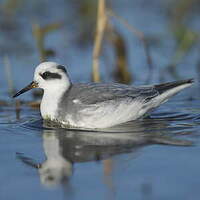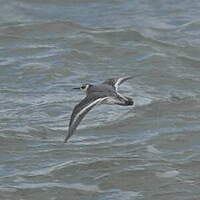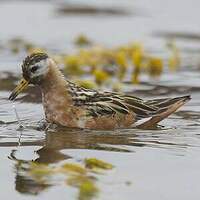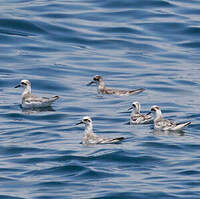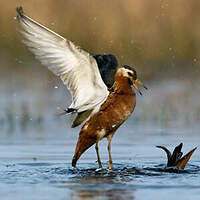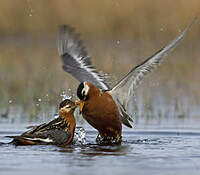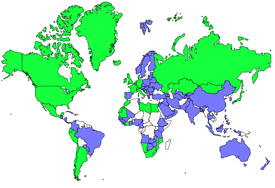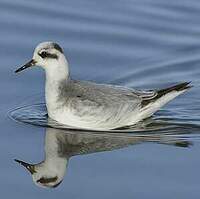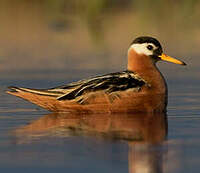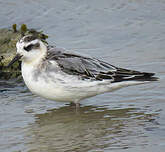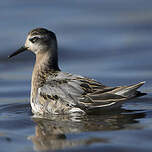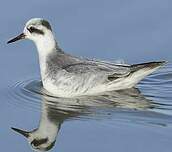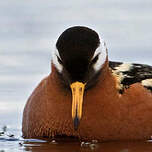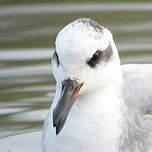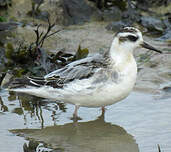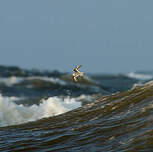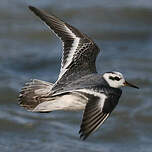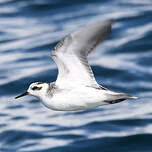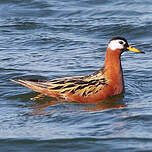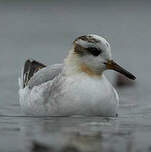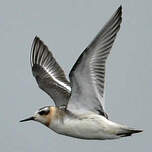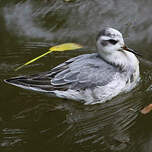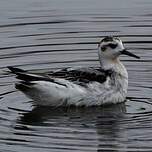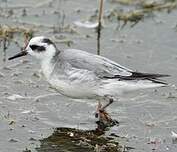Red Phalarope
Phalaropus fulicarius - Phalarope à bec large
Identification
Red Phalaropes are small wading water birds that can swim at the surface of the water with their lobed toes, which have extended side flaps for swimming. Two of them, the Red and the Red-necked Phalarope, spend the inter-breeding period at sea, only coming to land for breeding. The two species look very similar in winter plumage. That will be discussed later. Phalaropes have another unique feature among wading birds, which is reversed sexual dimorphism, with females being bigger and more brightly-colored than males.
The adult Red Phalarope is easily recognizable with its light brown color that covers its underside and neck. The female is brighter and more vivid in color. Its head is black and white, black on top, face and nape, white on the sides with a dark eye that stands out well. Its bills, particularly tall and wide, shorter than the head, is yellow with a black tip. The upper parts are black with tectrices edged white or fawn giving it a striated look. The wings are gray with a clear white wing bar, visible only when the wings are open. The underside of the wing and axillaries are white. Its tail is black. The male has a variable plumage. Some are close to the female, just with less vivid colors, while others are far from it, yet still recognizable (see the photos in the gallery).
The winter plumage is very different, as is usual with wading birds. It is gray and white, with some black. The upper parts, body and wing covers, are a rather pale gray. When newly molted, one can see the paler edges of the tectrices that disappear with wear, giving a uniform look.The underparts are all white. Remiges and rectrices are slate grey. The head is white with the nape, an oblique band behind the eye and a patch before the eye, black. The beak is black. From afar, the bird perched on the water looks like a miniature gull. In flight, the pale plumage and white wing bars resemble a winter Sanderling but the latter has a completely white head and a pale tail with central rectrices black.
The first winter plumage is quite similar to the previous one, but with some small differences that bring it closer to the winter slender one. You can list 3: 1- the black advances more forward on the head, 2- the sides of the head and the front of the neck are slightly tinged with russet cream, at least in early winter, 3- the top is not uniform grey like the adult one, there are blackish spots at the front and on the sides of the mantle. Some juvenile feathers may remain during fall migration.
The winter slender Red Phalarope is quite similar and can be a source of confusion. It's a bit smaller and slimmer. Its black beak, of headlength, is much thinner, a bit needle-like, and not widened. The tectrices of the mantle and scapulae are of a darker grey and their pale edges are wider and more noticeable, which gives the upper plumage a striated appearance. The beak remains the best criterion at a reasonable distance.
Be careful of transition plumages which can be complex to analyze.
Subspecific information monotypic species
Foreign names
- Phalarope à bec large,
- Falaropo picogrueso,
- falaropo-de-bico-grosso,
- Thorshühnchen,
- laposcsőrű víztaposó,
- Rosse Franjepoot,
- Falaropo beccolargo,
- brednäbbad simsnäppa,
- Polarsvømmesnipe,
- lyskonoh ploskozobý,
- lyskonoh ploskozobý,
- Thorshane,
- isovesipääsky,
- Grysfraiingpoot,
- escuraflascons becgròs,
- Þórshani,
- płatkonóg płaskodzioby,
- platknābja pūslītis,
- ploskokljuni liskonožec,
- Плосконосый плавунчик,
- ハイイロヒレアシシギ,
- 灰瓣蹼鹬,
- นกลอยทะเลสีแดง,
- 灰瓣足鷸,
Voice song and cries
Habitat
For reproduction, the Red Phalarope seeks coastal wetlands of the High Arctic, usually near the coast, rarely inland.
Apart from this, it is practically in the sea 11 months of the year. It undertakes long migrations on the high seas, which take it to tropical and subtropical ocean waters where it feeds on pelagic zooplankton. It is also the abundance of zooplankton that determines the migratory routes and stops.
Behaviour character trait
As we have seen, this species is mainly pelagic. However, during the Autumn storms, it can wander in small numbers to the European mainland, which is a joy for the observers to discover this Red Phalarope on a freshwater body, but not in its' full plumage.
Let's recall the two main features of this species. The first one is its strong link to aquatic environments. It has lobed toes, which allow it to swim efficiently. That is convenient because it spends 11 months out of the 12 at the open sea. It uses swimming when it looks for small zooplankton organisms close to the water surface.Inverse sexual dimorphism is rare among birds. It is the female that has a nice plumage, seducing males on the breeding sites, leaving the male to incubate the eggs and raising the chicks, then leaving him all the responsibility of the family and migrating before the chicks are emancipated.
Flight
Dietfeeding habits
On the Arctic breeding sites, it feeds on insects, their larvae, and small crustaceans in shallow water or near the shoreline.
During migration and wintering in the oceans, its feeding is highly specialized. The bird consumes pelagic zooplankton elements in deep-water upwelling zones. Prey spotting is done visually. Consumption rate may reach up to one prey per second in the areas with highest plankton concentration. It also looks for the vicinity of large cetaceans, probably for feeding reasons. It uses water surface tension to bring prey up to its bill and to the esophagus.Reproduction nesting
Breeding is late by necessity. Egg-laying usually happens from the end of May to the beginning of July, depending on latitude and local conditions.
Nesting is semi-colonial. The birds display nearby, often already coupled, but with possible surplus males available. The nest is a simple shallow scrape protected from water and hidden by herbaceous vegetation. In a time span of 2 to 4 days, the female lays 3 to 4 pale olive eggs with strong brown spots which the male will incubate for about 19 days. He'll take care of the young after hatching. The role reversal of the sexes is a custom among Red Phalaropes. Meanwhile, the female will disappear before the end of rearing, to go on migration.Geographic range
For breeding, the Red Phalarope searches the coastal marshes of the High Arctic, across two continents, including Greenland, Iceland, Spitzberg, and New Zemble. It winters at sea along the oceanic fronts, associated with concentrations of zooplankton, mainly in tropical and subtropical waters of the Pacific Ocean off the Americas, and in the Atlantic Ocean off the Caribbean on one side and the African coast on the other. It is not known to winter in the Western Pacific. Therefore, the Arctic Russian birds must migrate post-nuptially due west.
Threats - protection
IUCN conservation status
concern
in the Wild
threatened
evaluated
BirdLife International does not consider this species as threatened. It is limited to wet tundra regions at high latitudes, and its range is likely to decrease greatly in the 21st century. This is still an important threat and the species is thus classified as moderately vulnerable in Alaska.
The species is associated with Arctic Tern colonies and benefits from their alarm calls when in danger, mainly caused by the Arctic Fox. Some breeding colonies in Greenland have declined in the absence of Arctic Terns. (Information by BirdLife International.)
Sources of information
- IOC World Bird List (v14.1), Gill, F and D Donsker (Eds). 2024-04-18.
- Limicoles, gangas et pigeons d'Europe, Paul Géroudet (mise à jour Georges Olioso)
- Shorebirds, an identification guide to the waders of the world, Peter Hayman, John Marchant Tony Prater
- Birds of the World, The Cornell Lab of Ornithology
- xeno-canto, Sharing bird sounds from around the world,
Other sources of interest
 Specification sheet created on
27/07/2023 by Jean François
Specification sheet created on
27/07/2023 by Jean FrançoisTranslation by AI Oiseaux.net
published: 12-01-2021 - Updated: 03-02-2021
© 1996-2024 Oiseaux.net
- Accipitriformes
- Aegotheliformes
- Anseriformes
- Apodiformes
- Apterygiformes
- Bucerotiformes
- Caprimulgiformes
- Cariamiformes
- Casuariiformes
- Charadriiformes
- Ciconiiformes
- Coliiformes
- Columbiformes
- Coraciiformes
- Cuculiformes
- Eurypygiformes
- Falconiformes
- Galliformes
- Gaviiformes
- Gruiformes
- Leptosomiformes
- Mesitornithiformes
- Musophagiformes
- Nyctibiiformes
- Opisthocomiformes
- Otidiformes
- Passeriformes
- Pelecaniformes
- Phaethontiformes
- Phoenicopteriformes
- Piciformes
- Podargiformes
- Podicipediformes
- Procellariiformes
- Psittaciformes
- Pterocliformes
- Rheiformes
- Sphenisciformes
- Steatornithiformes
- Strigiformes
- Struthioniformes
- Suliformes
- Tinamiformes
- Trogoniformes

